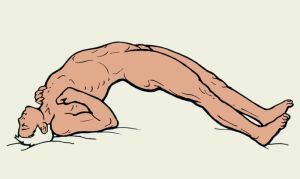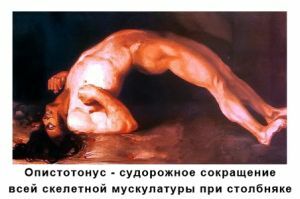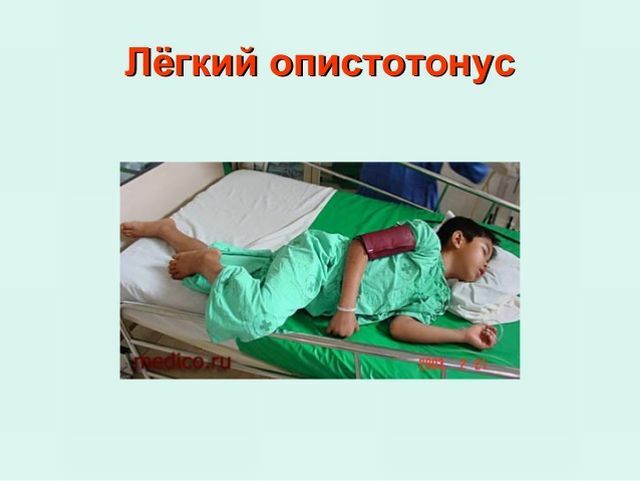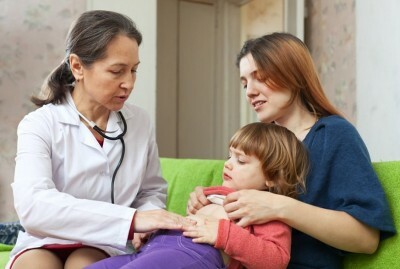 Opistonus represents a condition in which a person acquires an unnatural and convulsive pose characterized by cramping of cervical and dorsal muscles.
Opistonus represents a condition in which a person acquires an unnatural and convulsive pose characterized by cramping of cervical and dorsal muscles.
As a result, the patient, being on his back, takes an arched position, touches the surface of the bed with his head and heels bent backwards, and so long holds.
What triggers the development of a pose?
In most cases, the victims of this syndrome are children of both the breast and older age.
Opistonus is found when:
- is a hereditary disease of the nervous system, characterized by a disturbance in myelin metabolism or leukodystrophy, the occurrence of which is inherent in childhood;

- tetanus;
- infantile cerebral palsy;
- traumatic brain injury;
- unnatural processes in the middle brain and its bridge;
- tumors, hematomas and edema of the brain, including those that have arisen during birth injuries;
- meningitis;
- poisoning with functional poisons, especially cyanides.
Causes of opistonus in the infant:
- severe brain damage in the womb;
- hydrocephalus of occlusal type;
- trauma to the upper parts of the neck during childbirth.
In the maximum number of incidents, opistonus acts as a concomitant syndrome, manifestation or symptom of a primary ailment.
Sometimes the disease can provoke phenothiazine derivatives and other antideprisants. The disease can occur in children born from alcoholic mothers.
Mechanism of nucleation and development of
The control over the motor system and muscle tone of the human skeleton occurs as a result of the nerve cell-created rubrospinal pathway that begins in the midbrain. The neurons or red nuclei in it are connected to the cerebellum and other major parts of the brain that are functional in function.
The position of the opisthotonus begins when the brain stem crosses. The neurites of the red nuclei lying in the middle brain cover are moving to the opposite side. As a result of this, a crosshair of the midbrain is ventral or a cross of the Trout.
Next, the red nuclear-spinal path jumps to the lateral cord of the spinal cord.
The signals from the head to the spinal cord delivered by the red cores are then transmitted via the spinal nerves to the muscles of the flexors and extensors of the skeleton. In the process of disorganization of the adhesion of red nuclei to the complex controlling the reticular formation, there is a bright increase in the tension of the extensor muscles of the arms and legs, back and head.
The disease is exacerbated by the manifestation of inflammatory processes in the membranes of the brain, destruction of the cerebellum and hemorrhagic stroke.

How it looks on the part of
Immediately the pose of opistonus is a sign of a serious brain disease of a person. The first symptom is a typical convulsive unnatural position, in which:
- being on the back, the patient touches the surface with the back of the head and heels;
- hands and feet, fingers tensely bent, and legs rigidly straightened
The condition in which a person is in the arc, holds a significant time period. During the seizure, the posture differs significantly from the usual stoop, becomes abnormal with a displacement of the indicated limbs and head. The type of posture depends on the type and amount of damage to the brain.
Thus, the manifestation of previous postures of primary signals of strength of the dorsal and cervical muscles becomes an occasion for urgent medical attention.
Diagnostic criteria and therapy
If you have a characteristic posture for the disease, you need to immediately apply for emergency care. Further it is necessary to conduct a full examination of the patient in the hospital.
After stabilization of the condition, physicians are obliged to examine in detail the nervous system of the patient, to study the patient's medical history and relatives, to collect analyzes and to carry out the necessary diagnostics.
The attending physician should find out the time of the onset of symptoms, the nature and regularity of the postures, others manifested before or simultaneously with the arched position of the symptoms, the presence of head injuries and the facts of using narcotic drugs.

For the correct diagnosis it is necessary to collect the following tests and conduct tests:
- study of blood and urine, electrolytes;
- cerebral angiography;
- perform spinal puncture and perform material analysis;
- magnetic resonance imaging and computed tomography of the head;
- analysis of intracranial pressure;
- electroencephalography.
When making a diagnosis it is necessary to be able to distinguish opistonus from a hysterical arc. In the process of a fit of hysteria, the patient's body also takes an arcuate bend, but spasms and convulsions only appear in the presence of observing persons, the creation is not oppressed.
A man in a fit can arbitrarily change his position that a patient with opistonus can not do it.
 Due to the fact that the pose is more pronounced in children with purulent inflammation of the brain envelopes and tetanus, it is necessary to monitor the position of the child, in the process of his excitement and anxiety.
Due to the fact that the pose is more pronounced in children with purulent inflammation of the brain envelopes and tetanus, it is necessary to monitor the position of the child, in the process of his excitement and anxiety.
In time, the revealed characteristic posture contributes not to belatedly turning to a doctor, including calling an ambulance, hospitalization and the proper appointment of therapy methods.
In a medical institution, the patient being placed in intensive care is treated for the very manifestation of the disease, and then its causes. If opistonus causes difficulty breathing, then to exclude the dislocation of the brainstem, a patient in the neurosurgical department is put a breathing tube.
After stabilization of the state, complex and thorough diagnostics are carried out, as a result of which they reveal the causes of spasms, prescribe a course of treatment, including with the use of spasmolytic drugs.
The danger of the phenomenon is determined by the causes that caused the syndrome. Therefore, the ontogeny of the disease as a result of injuries or lesions of the brain and nervous system is very dangerous.
The result of opistonus can be:
- inability to communicate;
- coma;
- paralysis;
- death.
Thus, opistonus is a serious symptom of infectious diseases and serious head injuries that need to be diagnosed and treated in a timely manner. Pregnant should be responsible for bearing fruit, abandon bad habits.



